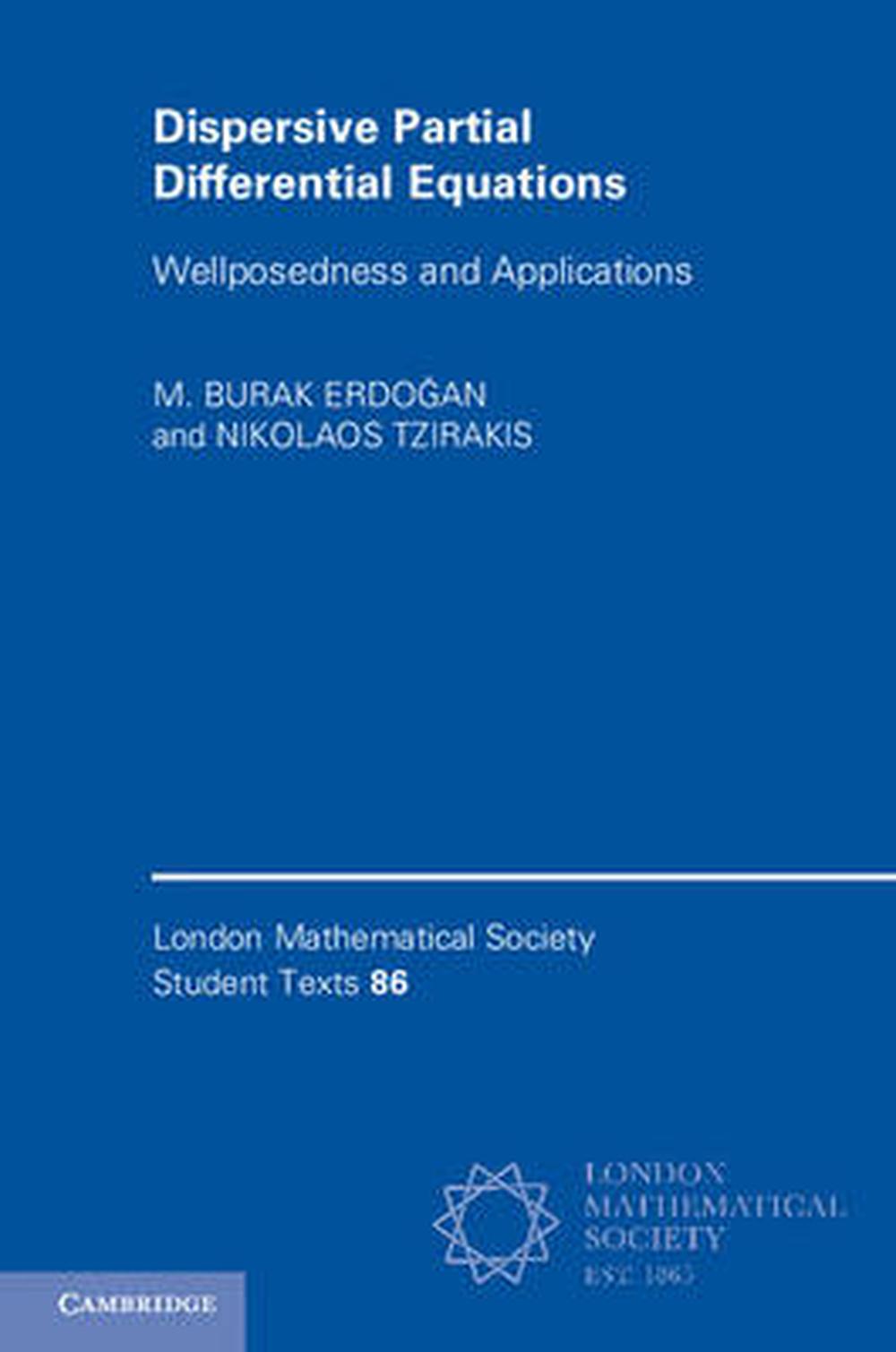
When you click on links to various merchants on this site and make a purchase, this can result in this site earning a commission. Affiliate programs and affiliations include, but are not limited to, the eBay Partner Network.
Dispersive Partial Differential Equations: Wellposedness and Applications by M.

- Item No : 236014307131
- Condition : Brand New
- Brand : No brand Info
- Seller : the_nile_uk_store
- Current Bid : US $80.47
-
* Item Description
-
The Nile on eBay

Dispersive Partial Differential Equations
by M. Burak Erdogan, Nikolaos Tzirakis
Provides a self-contained and accessible introduction to nonlinear dispersive partial differential equations (PDEs) for graduate or advanced undergraduate students in mathematics, engineering, and physical sciences. The book can be used for self-study, or for teaching a semester-long introductory graduate course in PDEs.
FORMAT
PaperbackLANGUAGE
EnglishCONDITION
Brand New
Publisher Description
The area of nonlinear dispersive partial differential equations (PDEs) is a fast developing field which has become exceedingly technical in recent years. With this book, the authors provide a self-contained and accessible introduction for graduate or advanced undergraduate students in mathematics, engineering, and the physical sciences. Both classical and modern methods used in the field are described in detail, concentrating on the model cases that simplify the presentation without compromising the deep technical aspects of the theory, thus allowing students to learn the material in a short period of time. This book is appropriate both for self-study by students with a background in analysis, and for teaching a semester-long introductory graduate course in nonlinear dispersive PDEs. Copious exercises are included, and applications of the theory are also presented to connect dispersive PDEs with the more general areas of dynamical systems and mathematical physics.
Author Biography
M. Burak Erdogan is a professor in the Department of Mathematics at the University of Illinois, Urbana-Champaign. Nikolaos Tzirakis is an associate professor in the Department of Mathematics at the University of Illinois, Urbana-Champaign.
Table of Contents
Preface; Notation; 1. Preliminaries and tools; 2. Linear dispersive equations; 3. Methods for establishing wellposedness; 4. Global dynamics of nonlinear dispersive PDEs; 5. Applications of smoothing estimates; References; Index.
Review
'The exercises in each chapter, while not at all trivial, tremendously enhance one's understanding of the material. The focus on periodic boundary conditions sets this book apart from related ones in the area, and yet the authors do a nice job discussing related well-posedness results and estimates on the real line as well. While certainly not meant for students without any analysis background, a thorough work-through of this book certainly brings one to the frontier of the theory of nonlinear dispersive PDEs.' Eric Stachura, MAA Reviews 'The book is a manual for beginning graduate students in the field of the general theory of nonlinear partial differential equations. The material is presented in the rigorous mathematical style, providing proofs of formal theorems, rather than less strict considerations which may be often encountered in physics literature.' Boris A. Malomed, Zentralblatt MATH 'The exercises in each chapter, while not at all trivial, tremendously enhance one's understanding of the material. The focus on periodic boundary conditions sets this book apart from related ones in the area, and yet the authors do a nice job discussing related well-posedness results and estimates on the real line as well. While certainly not meant for students without any analysis background, a thorough work-through of this book certainly brings one to the frontier of the theory of nonlinear dispersive PDEs.' Eric Stachura, MAA Reviews 'The book is a manual for beginning graduate students in the field of the general theory of nonlinear partial differential equations. The material is presented in the rigorous mathematical style, providing proofs of formal theorems, rather than less strict considerations which may be often encountered in physics literature.' Boris A. Malomed, Zentralblatt MATH
Review Quote
'The exercises in each chapter, while not at all trivial, tremendously enhance one's understanding of the material. The focus on periodic boundary conditions sets this book apart from related ones in the area, and yet the authors do a nice job discussing related well-posedness results and estimates on the real line as well. While certainly not meant for students without any analysis background, a thorough work-through of this book certainly brings one to the frontier of the theory of nonlinear dispersive PDEs.' Eric Stachura, MAA Reviews
Promotional "Headline"
Introduces nonlinear dispersive partial differential equations in a detailed yet elementary way without compromising the depth and richness of the subject.
Description for Bookstore
Provides a self-contained and accessible introduction to nonlinear dispersive partial differential equations (PDEs) for graduate or advanced undergraduate students in mathematics, engineering, and physical sciences. The book can be used for self-study, or for teaching a semester-long introductory graduate course in PDEs.
Description for Library
Provides a self-contained and accessible introduction to nonlinear dispersive partial differential equations (PDEs) for graduate or advanced undergraduate students in mathematics, engineering, and physical sciences. The book can be used for self-study, or for teaching a semester-long introductory graduate course in PDEs.
Details
ISBN1316602931Author Nikolaos TzirakisPublisher Cambridge University PressSeries London Mathematical Society Student TextsYear 2016ISBN-10 1316602931ISBN-13 9781316602935Format PaperbackImprint Cambridge University PressSubtitle Wellposedness and ApplicationsPlace of Publication CambridgeCountry of Publication United KingdomDEWEY 515.353Short Title DISPERSIVE PARTIAL DIFFERENTIALanguage EnglishMedia BookSeries Number 86Pages 197Publication Date 2016-05-03Illustrations Worked examples or ExercisesAudience Professional and ScholarlyUK Release Date 2016-05-03AU Release Date 2016-05-03NZ Release Date 2016-05-03


-
- The Lost Super Foods
- $ 37.00
- The Self-Sufficient Backyard
- $ 37.00
- A Navy Seals BUG IN GUIDE
- $ 39.00
- Childrens Books Phonics Lot 60
- $ 34.99
















